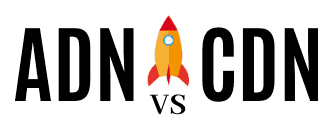There are many different components you need to consider when you want to improve website performance. One of the critical mistakes many people make is looking at a bunch of similar abbreviations and assuming they are interchangeable. In reality, a high-performance website consists of many moving parts that are not necessarily apparent from the end-user point of view.
An excellent example of this juxtaposition is the tendency to confuse the terms ADN and CDN. Although they may seem similar and there is some overlap as we will see, they each perform particular tasks that are autonomously vital elements to improving website performance.
Let’s start with the definitions. “ADN” is generally recognized to mean “application delivery network,” while “CDN” stands for “content delivery network” or “content distribution network.” Though it is true that CDNs do make the task of application performance management (APM) more complex, they are often considered to be reasonable value and a relatively inexpensive way to handle content and scalability for your website.
At the same time, CDNs can also be somewhat sloppy, and there is the potential for confusion. The problem stems from the practice of many people using “CDN” as a broad catch-all term which includes ADN.
So what are the differences between ADNs and CDNs, and why does it matter?

CDNs and ADNs have quite a bit in common, including benefits of performance, demand pricing, security, and availability. They also share many techniques, including TCP optimization, load-balancing, and caching. To be honest, the boundaries between CDNs and ADNs are somewhat nebulous. But despite the overlap in functionality, it’s important to understand the basics of each, if only to clarify your own organization’s requirements.
CDNs work by caching frequently accessed digital content at geographically distributed edge locations. When a client browser requests the cached content, it comes from the nearest edge location. By utilizing these edge locations in a strategic geographical pattern, static websites will see significant performance improvements. But for remote applications accessed over the public internet, this practice of caching content at edge locations fails to yield the same performance improvements.
By comparison, ADN is a combination of features that provide application availability, security, visibility, and acceleration. You can check out our Learning Center article “What is Application Delivery Network (ADN)?” for more in-depth technical analysis.
In short, ADNs work with dynamic remote applications, requiring the delivery of real-time data, analytics, and user preferences between the application server and the client. Because every client has different data, each request is fetched from the origin server. Remote applications also require an intelligent traffic monitoring and management solution for distributing network traffic over multiple servers.
Now, to correctly understand the subtle yet important differences between the two protocols, it may be informative to take a look at a high-profile application of both a CDN and ADN function.
ADN: Uber

Uber is a ride-sharing service available in 83 countries and over 674 cities worldwide, all managed by a mobile app. Claiming over 77% of the US ride-sharing market, Uber’s mobile app fulfills over 40 million separate rides each month.
Uber relies heavily on ADN for many reasons, but mainly because its global user base is growing rapidly. To assure their data can be delivered fast and safe, ADN is the only solution. Uber uses an ADN to reduce server latency by distributing its data load evenly across multiple servers. By spreading the load among multiple servers, the odds of any one server getting overloaded are significantly reduced.
Naturally, Uber’s traffic far exceeds most companies; they operate under a Multi CDN (ADN) strategy. Mlytics’ Multi CDN feature is built upon multiple ADNs to support this kind of massive global content request.
CDN: Washington Post

The Washington Post is a major news website featuring over 83 million visitors each month. Unlike Netflix, the Washington Post heavily relies on CDNs to deliver content to readers either locally or around the globe.
The CDN is designed to support essential content such as HTML, CSS, JS, photos, and videos. Blogs, news organizations, magazines, and corporate websites are ordinarily filled with this type of content without any interactable functionality/application. As a result, the CDN can handle as much or as little traffic as is thrown its way. By using Points of Presence (PoPs), otherwise known as edge caches to mirror the static content at the server origin and reflect it to a closer end-user, a CDN.
ADN vs. CDN, which should you use?
After reviewing the information presented above, deciding whether to go with an ADN or a CDN should not be a tough choice. If your website does not have heavy interactable functionality/application, then a CDN is going to be your best bet in not only regarding performance but also concerning cost-effectiveness for your organization.

Alternatively, if your website is continuously changing or serves as an interactive terminal to functional web-based software, then ADN is the ideal candidate.
Regardless of which platform you choose, a major consideration in determining your ADN/CDN provider is their ability to provide global coverage based on your needs. While some ADN/CDN providers perform better in Region A, they may not be able to deliver the same performance in Region B. When evaluating the situation before making a decision, be sure to consider not only where your organization is today, but where you plan on being in five or ten years. Forward thinking can save considerable money and resources when it comes to choosing an ADN/CDN provider.
Finally, remember that ADN is still not a commonly used term, so some CDN products may actually be ADNs. Do your due diligence and be sure to ask questions before you make a decision!



